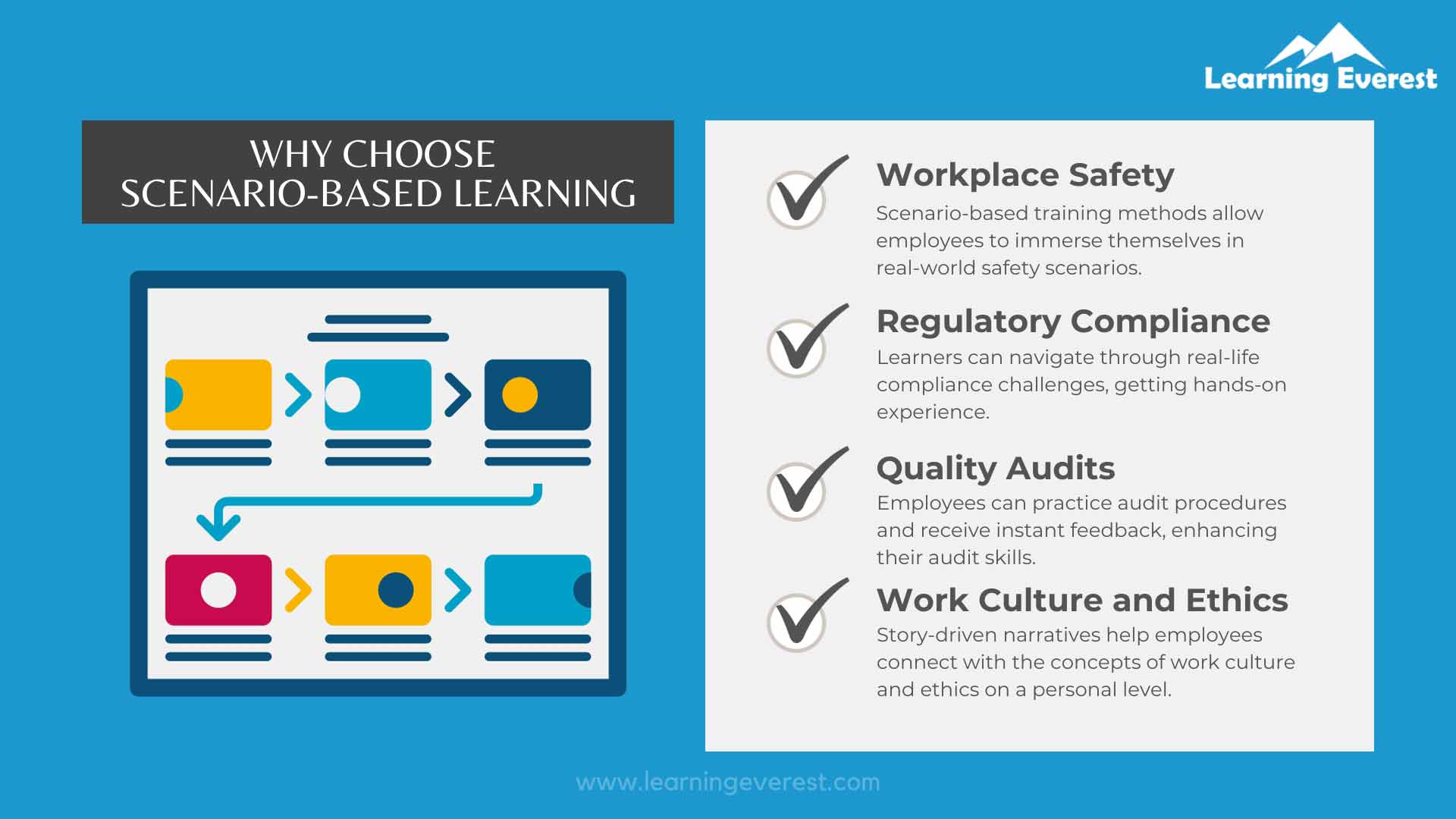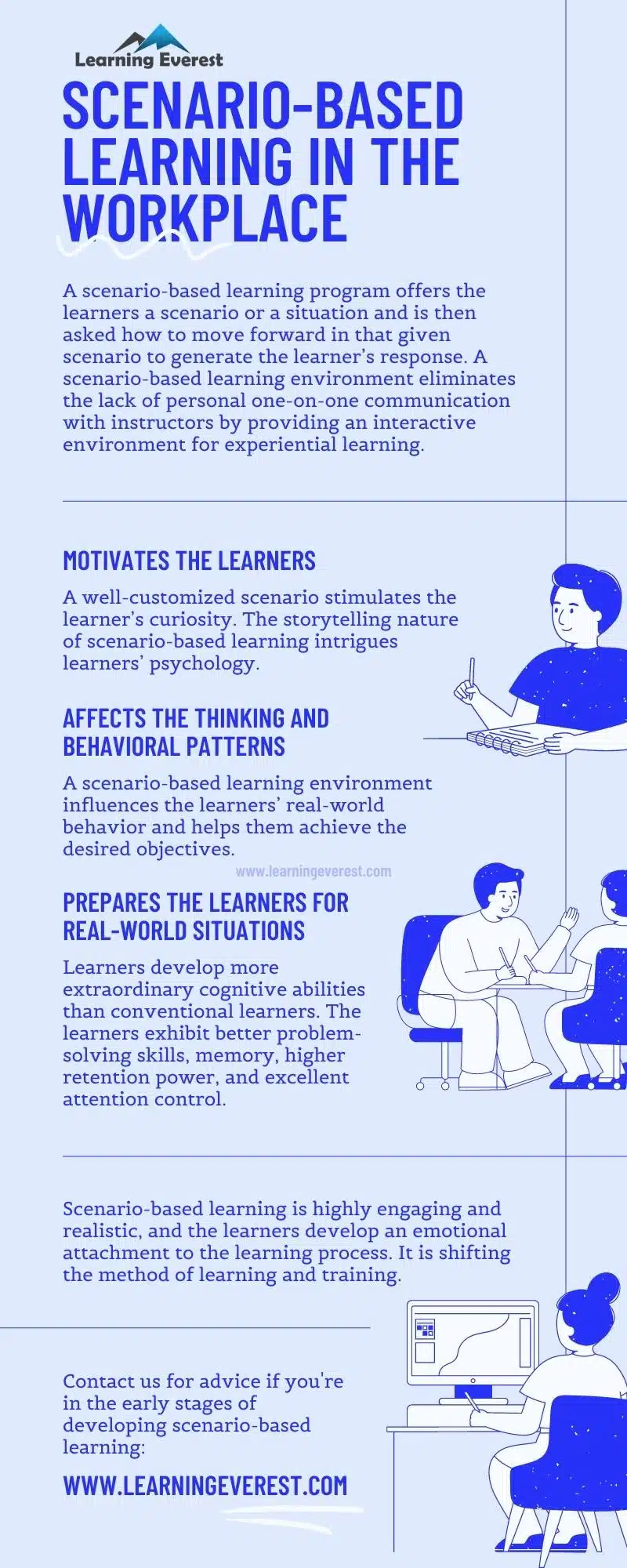In this article you will understand everything you need to know about scenario-based learning, including the types of scenario-based learning, what is a scenario and, benefits of scenario-based learning.
Table of Contents
What is a scenario?
A scenario is a story with characters and real-life conflicts and situations. A scenario-based learning program offers the learners a scenario or a situation and is then asked how to move forward in that given scenario to generate the learner’s response. This type of learning is based on the situated learning theory formulated by Lathe and Vendor in 1991. A scenario works just like those stories you read. Instead of teaching through instructions, a scenario helps learners visualize situations involving characters playing specific roles. Here the learner gets to make certain decisions based on the situation, leading to positive or negative consequences.
A scenario-based learning environment eliminates the lack of personal one-on-one communication with instructors by providing an interactive environment for experiential learning. This type of learning aims to identify a solution or response to a real-life issue. Through scenario-based learning, it is possible to provide compliance training, soft skills training, professional skills training, leadership training, etc.
What are the types of scenario-based learning?
Scenario-based learning would work well where decision-making has to be done under pressure in a real-life situation. Here are a few great examples,
- Health and safety compliance training: Where you need to see that learners understand a procedure before giving them access to a site or equipment. Scenario-based learning is a great opportunity to put a learner in someone else’s shoes and see how different decisions could lead to different outcomes.
- Deciphering a dialogue and anticipating where soft skills and language can alter the outcomes: Each choice becomes a microlearning opportunity. By seeing the consequences of each choice, learners can see where those decisions might lead.
- A medical emergency simulation: Using scenario-based learning means that critical decisions can be made in a safe environment without any real risk to learners or to others – or in some cases, to valuable equipment.
- Behavioral training: Behavioral skills affect how someone behaves toward their roles, responsibilities, and others. Using appropriate scenarios can make the trainees able to train employees effectively.
- Onboarding training: It introduces and integrates new employees or customers into their new roles at an organization. Organizations can use scenario-based learning to train new employees.
- Compliance training: Compliance training courses often use scenarios to test an employee’s decisions based on a set of situations.
- Safety training: Organizations often use scenarios to recreate safety and quick response situations. Scenarios are also used to recreate machine operating procedures.
- Soft-skills training: When it comes to soft-skills training, scenario-based training is the best option to train many employees quickly.
- Leadership training: Scenario-based learning, where leadership is the main focus, can be an excellent approach to building employees’ leadership skills in the workplace.
- Sales training: Mock sales pitching is a form of scenario recreation and has traditionally been used by salespeople to practice their selling skills under various situations.
- Customer service training: Just like sales pitching, customer interactions can be practiced in safe environments by customer relation specialists to maximize their problem-solving and objection-handling skills.

Why Choose Scenario-based Learning
5 Benefits of scenario-based learning
Scenario-based learning incorporates storytelling in the eLearning content. It makes the eLearning content which is full of data and information, more engaging and impactful to its learners. It enhances the process of solving problems. Here are some reasons why scenario-based learning adds value to a learning journey:
Motivates the learners
A well-customized scenario stimulates the learner’s curiosity. Curiosity helps them to want to know more about what happens next. The storytelling nature of scenario-based learning intrigues learners’ psychology. Therefore, naturally, this type of learning helps to generate a sense of motivation in the learners.
Prepares the learners for real-world situations
Compared to traditional learning experiences, scenario-based learning is more likely to produce effective outcomes. Learners develop more extraordinary cognitive abilities than conventional learners. The learners exhibit better problem-solving skills, memory, higher retention power, and excellent attention control.
Affects the thinking and behavioral patterns
A scenario-based learning environment influences the learners’ real-world behavior and helps them achieve the desired objectives. For that, scenario-based learning must be well designed, accounting for all the variables in the learner’s real life.
Promotes learning through experience
Scenario-based learning provides fundamental and relevant knowledge to the learners. It also generates essential skills such as problem-solving, critical thinking, teamwork, and communication.
Better completion rates
A scenario-based learning environment is exceptional for keeping the learners engaged throughout their learning journey. It creates real experiences. By leveraging audio-visual techniques as a reality, scenario-based learning transforms how learners used to learn hitherto and makes it an easily graspable form of eLearning.
Infographics
Knowledge Check!
Conclusion
To summarize, scenario-based learning is highly engaging and realistic, and the learners develop an emotional attachment to the learning process. It is shifting the method of learning and training. While promoting learning through experience, scenario-based learning prepares them to face real-world challenges.
Incorporate scenario-based learning into your training programs today and experience the numerous benefits firsthand. Try it now!






